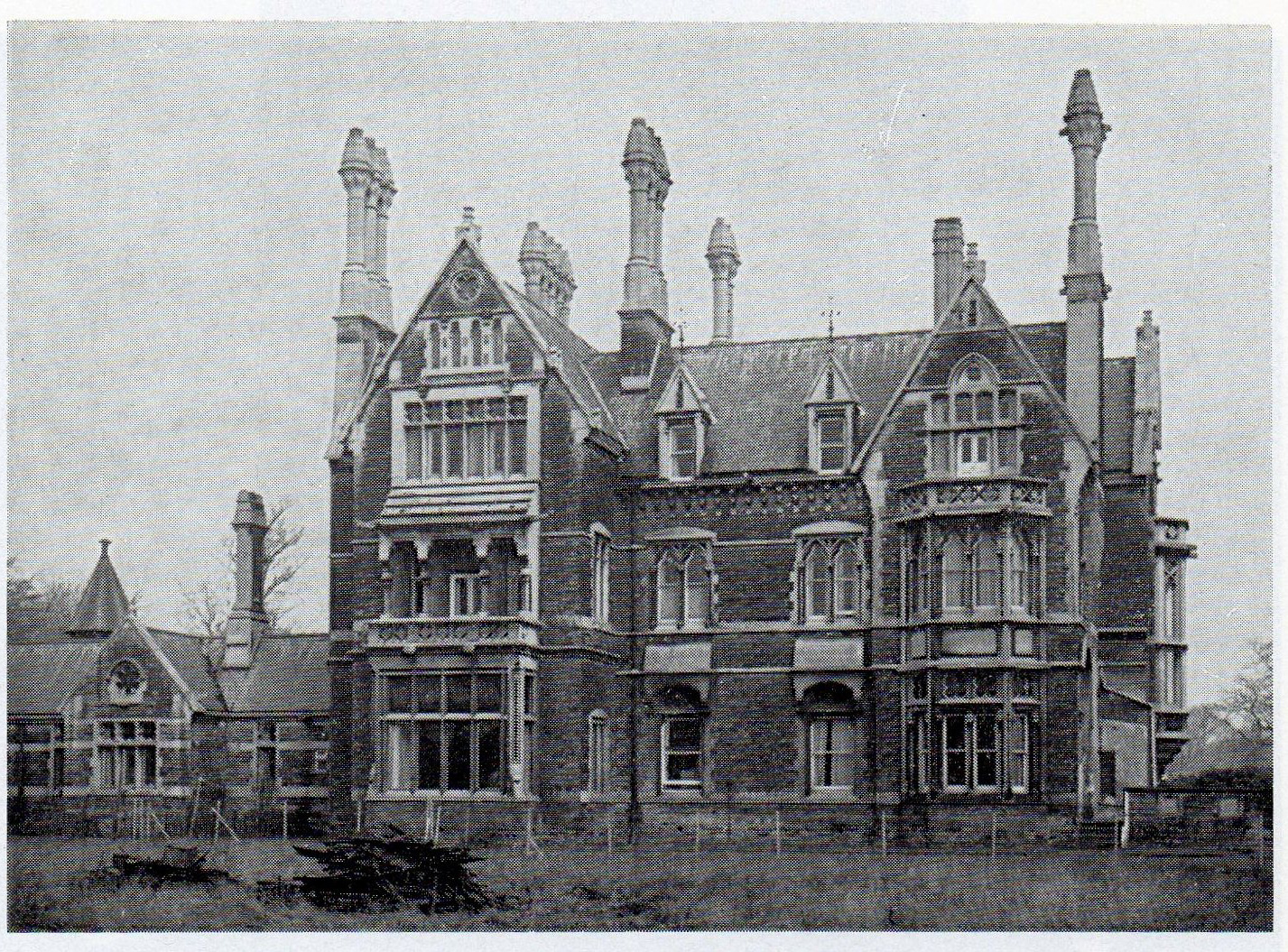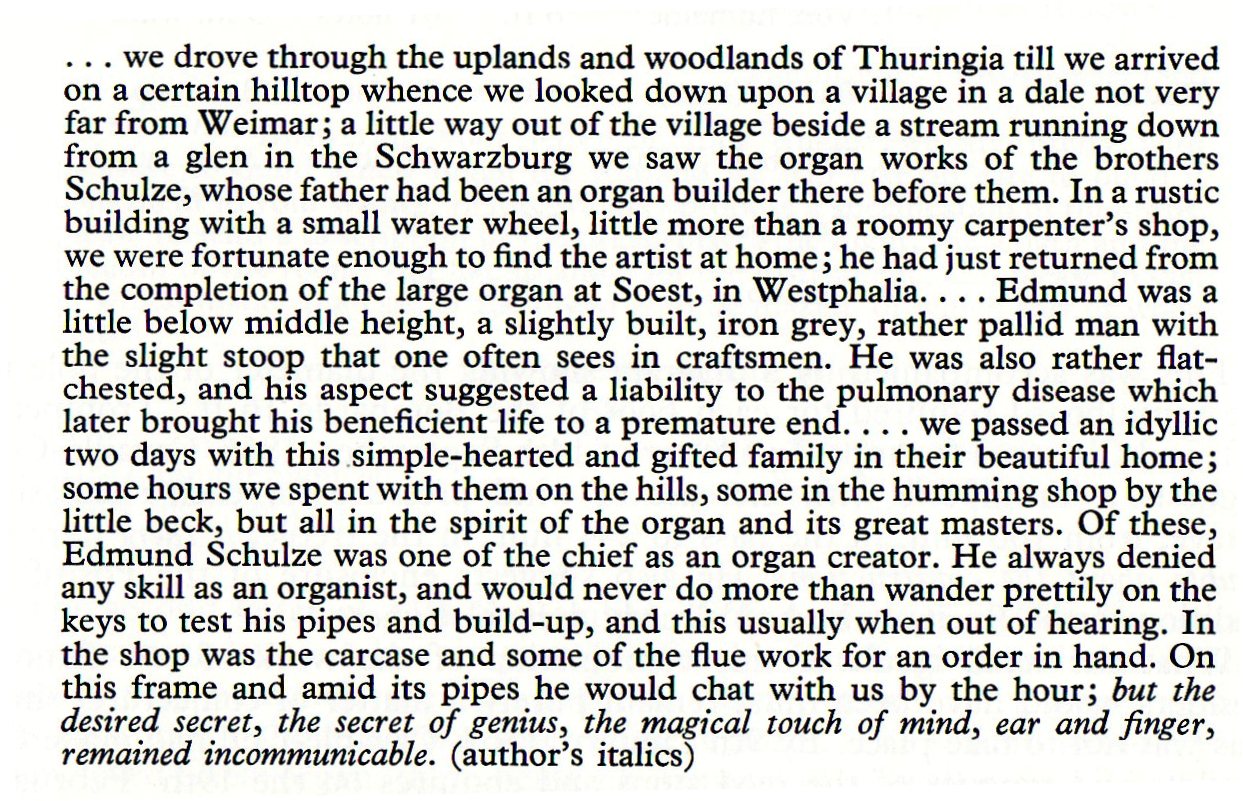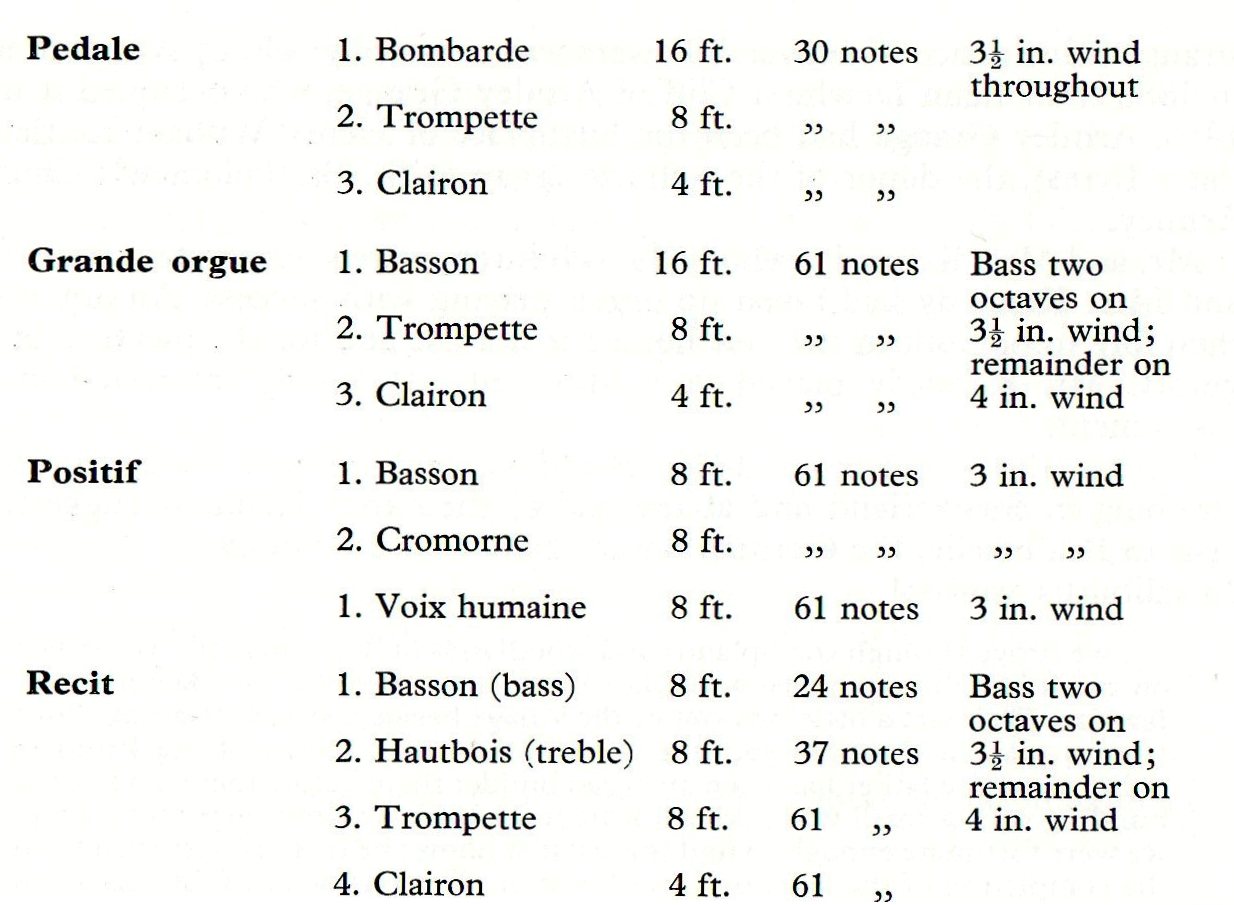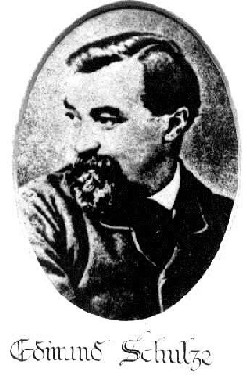|
|
FUGUE:
CHAPTER I
CLIFFORD
ALLBUTT & STUART KENNEDY VISIT THE ORGAN WORKS OF
J.F.SCHULZE
& SONS AT PAULINEZELLE, THURINGIA

|
The
story of the Schulze family of organ-builders begins in
Thuringia, the "green heart" of Germany where, amidst
lovely scenery of hills, valleys and mountain streams, Johann
Sebastian Bach was born, travelled and worked. The accompanying
map shows several places known to Bach - Eisenach, Mühlhausen,
Arnstadt, Köthen and Leipzig - in addition to those later
associated with the name of Schulze.
Here
in Milbitz, shortly after the death of J. S. Bach (1750) and of
the great organ-builder Gottfried Silbermann (1753), Johann
Andreas Schulze was born in 1753.38 He built many church organs
in his native country, including those at Stadtilm, Kahla and
Milbitz, the latter being an instrument of 21 stops in the
early romantic style, with the characteristic emphasis on 8ft.
(i.e. unison) stops of different tonal qualities, including
"string" tones. Johann Andreas died in 1806 and was
succeeded by his son Johann Friedrich Schulze, born at Milbitz
in 1793 who, after his father's death, worked for a time with
Witzemann, an organ-builder of Stadtilm near Arnstadt.
He
became interested in acoustics and especially in the theories
of Gottlob Töpfer, professor of music, organist of Weimar
and author of the famous treatise on organ-building which
influenced many of the lesser organ-builders of central
Europe.45 Schulze was also influenced by the careful
constructional work of Gottfried Silbermann and by the powerful
flue choruses of that great builder, both of these features
becoming traditional in the work of the Schulze firm.
|
Johann
Friedrich Schulze moved in 1826 to Paulinzelle (now generally
designated Paulinzella), with a second workshop to the north-west
at Mühlhausen, and was able to rebuild the unsatisfactory
organ of Weimar Stadtkirche in first-rate style - a success which
brought the Schulze firm to the forefront of organ-building in
Germany. He built large organs at Quedlinburg, Bremen and
Halberstadt. The three-manual and pedal organ of Weimar was
definitely romantic in design, with many 8ft. stops of different
tonal qualities on the manuals, including string-toned ranks such
as a Viola da Gamba 8ft. (and 4ft.) played from the first manual,
a Violon 16ft. on the pedal organ, and Lieblich Gedacts 8ft. and
4ft. on the third manual which were later to become so popular in
England. Each manual however had a well developed Principal
chorus, including mixtures.
Prince
Albert of Saxe-Coburg & Gotha, an amateur organist and
composer, was familiar with the Schulze organs both in the
churches and in the royal and ducal palaces of Gotha. After his
marriage to Queen Victoria, as Prince Consort, he invited J. F.
Schulze to send an organ to the Great Industrial exhibition in
1851 of which he was the prime mover and which was held in the
Crystal Palace, on its original site in Hyde Park, London. This
small two-manual and pedal organ of 18 stops, one of 14 organs
exhibited, was awarded a prize medal and aroused great interest
because of the beauty and fullness of tone of the flue stops.
Purchased for £210, this organ went to the Exchange Room,
Northampton, was enlarged by the addition of a third manual by
Stolz of Paris, but was thereafter neglected and finally
lost!
The
Great Exhibition instrument was the commencement of the great
popularity of Schulze organs in England - especially in Yorkshire
and Lancashire, where robust diapason choruses were admired and
where organ-building was supported by wealthy business men. It was
examined by Jeremiah Rogers, organist of Doncaster Parish Church,
who was instrumental in obtaining for J. F. Schulze & Sons the
contract of 1857 for a large organ to replace the instrument lost
in the great fire of 1853, which had destroyed both the church and
its organ. The small exhibition organ also showed evidence of
Schulze's inventive mind, for the pedal-board was made slightly
concave, although parallel. This was noted by Samuel Sebastian
Wesley and Henry Willis and was the origin of the Wesley-Willis
concave and radiating pedalboard which, with modifications, is now
in general use in Britain and America.
J.
F. Schulze died of a chest condition in 1858, after the completion
of his largest instrument in the Marienkirche, Lübeck, with
four manuals and two pedal-boards, the second of which was
inclined at an angle of 40° - all to be destroyed during an
air raid in 1942. The Doncaster organ, opened in 1862, was
therefore greatly the work of J. F. Schulze's son Edmund and its
specification was an enlarged version of that of the Lübeck
instrument.
Of
the six sons of J. F. Schulze, the eldest, Heinrich Edmund
(1824-78), generally known as Edmund Schulze, became head of the
firm on his father's death and was responsible for the design,
voicing and finishing of the Schulze organs destined for England.
Oskar Schulze (1825-78) was greatly esteemed in his native country
as an acoustician and "Orgelbautheoretiker." Eduard
Schulze (1830-80), a younger brother, was a capable organ-builder
who would complete a new organ in the absence of Edmund when the
latter was finishing an organ elsewhere. He probably came to
Armley after the death of both Edmund and Oskar to supervise the
erection of the organ on the new gallery in the north transept,
with the addition of the Open Metal 16ft. (originally named Metal
Principal 1 Bass) and the Sub Bass 32ft. stops, just completed.
Eduard was then in poor health and greatly distressed by the loss
of his two brothers. After the completion of the Armley organ and
of a two manual and pedal organ for St. Peter's Church, Harrogate,
he suffered a stroke and died in the following year.
Herwart
Schulze (1830-1908), the fourth brother, was responsible for the
excellent joinery of the instruments in his earlier years, but
later settled in London as woodcarver and gilder to a Mr. Knox of
Kennington Lane, until summoned home to Paulinzelle on the deaths
of his brothers to wind up the affairs of the firm. He later
continued in business at Nordhausen, to the north of Paulinzelle,
(see map above) as a woodcarver, which occupation he
preferred to organ building. The fifth brother Franz became
Musikdirektor at Naumberg and the sixth was a mill-owner. Thus the
firm of J. F. Schulze & Sons came abruptly to an end in 1879
and a notice in the Orgelbauzeitung (organ-builders' news) ends
with the words:
"So
geht mit dem Tod Vernichtung Hand in Hand"
"Thus
goes Dissolution hand in hand with Death"
Sir
Thomas Clifford Allbutt, was truly described by Dr. W. L.
Sumner as Edmund Schulze's English "Boswell," without
whose memoirs much of the history of the Armley organ would
have been lost. The son of the Vicar of Dewsbury, he became an
eminent hospital physician and consultant in Leeds from
1861-1889. A member of the Fell and Rock Climbing Club of the
English Lake District, he was an active alpine climber from his
student days at Cambridge and became a travelling and climbing
companion of Thomas Stuart Kennedy, for whose wife the Schulze
organ was built at Meanwood, Leeds.
Allbutt's
artistic interests ranged widely, including a great love of the
organ and the music of J. S. Bach. A few months before his
death, he forwarded his reminiscences of musical matters in
Yorkshire to his friend Dr. Alan Gray of Cambridge. These
included his recollections of the visit which he and Kennedy
made to Paulinzella, the evolution of the specification of the
Meanwood organ and his personal impressions of Edmund Schulze
and his work.
|
|
 Thomas
Allbutt, 1836-1925
Thomas
Allbutt, 1836-1925
|
Allbutt
had received from a Mr. Jones of Harrogate, one of Mrs. Kennedy's
executors, many of the original letters, written chiefly in the
German Kurrentschrift (i.e. running hand), from J. F. Schulze &
Sons to Kennedy; also others from Aristide Cavaillé-Coll,
the eminent French organ-builder, relating to the building of the
organ. These letters are now the property of St. Bartholomew's
Church, Armley, and are in the safe custody of the Leeds City
Archives Department. Extracts from the Allbutt reminiscences were
published, edited by Dr. Alan Gray, in 1925 and, although
containing some inaccuracies, they are invaluable to the historian
of the Armley organ.
In
his early years, Allbutt knew Charlotte and Emily Bronte - members
of another gifted family to fall victims to pulmonary
tuberculosis, as did the Schulze brothers.
Sir
Thomas was knighted in 1907. His artistic interests ranged widely,
including a great love of the organ and the music of J. S. Bach. A
few months before his death, he forwarded his reminiscences of
musical matters in Yorkshire to his friend Dr. Alan Gray of
Cambridge. These included his recollections of the visit which he
and Kennedy made to Paulinzelle in 1866, the evolution of the
specification of the Meanwood organ and his personal
impressions of Edmund Schulze and his work.
Thomas
Stuart Kennedy was born in Wallsuches, Lancashire, on 26th
April, 1841, the son of Mr. Peter Kennedy (brother-in-law of
Sir Peter Fairbairn of Leeds). His father being in business in
Zurich, Kennedy's childhood was spent in Feldkirch, being
educated first in Geneva and later in Westmorland and
Dumfriesshire. In 1859 he joined his cousin Sir Andrew
Fairbairn's engineering works at the Wellington Foundry, Leeds,
becoming a partner in the firm of Fairbairn, Kennedy &
Naylor (now Fairbairn Lawson Ltd.)
On 1st June, 1865, in
Canterbury Cathedral, T.S. Kennedy married Clara, the second
daughter of the late Henry George Thornton, a medical
practitioner of Sturry, near Canterbury. Although the direct
connection cannot now be traced, it is most probable that Clara
was a member of the well-known Thornton family with many
clerical connections including Canterbury, since a member of
that family was resident in the Cathedral Precincts at the same
time as was Clara immediately before her marriage. For this
information grateful acknowledgement is made to Miss Anne M.
Oakley, Archivist, Canterbury.
|
|
 Thomas
Kennedy, 1841-1894
Thomas
Kennedy, 1841-1894
|
After
Stuart Kennedy's death in 1894 Allbutt had received from a Mr.
Jones of Harrogate, one of Mrs Clara Kennedy's executors, many
original letters, written chiefly in the German
Kurrentschrift (running hand) from J F Schulze & Sons to
Kennedy and others in French from Aristide Cavaillé-Coll,
the eminent French organ-builder, relating to the building of the
Kennedy organ. These letters are now the property of St.
Bartholomew's Church, Armley, and are in the safe custody of the
Leeds City Archives Department. Extracts from the Allbutt
reminiscences were published, edited by Dr. Alan Gray, in 1925
and, although containing some inaccuracies, they are invaluable to
the historian of the Armley organ. after he Kennedys lived first
at Shaw House, Far Headingley, Leeds.
The
Kennedys lived first at Shaw House, Far Headingley, Leeds.
In 1866 Kennedy employed the architect Edward
Welby Pugin to design a new home “Carr House” in
Meanwood, Leeds, Pugin was the eldest son of Augustus Pugin “the
high priest of Victorian Gothic”, and a friend of Kennedy’s
parents. Edward designed a very tall, Neo-French
Rennaisance/Gothic-style mansion which was completed in 1867.
Edward was already working in Yorkshire, building extensions to
Mount St. Mary’s Church in Leeds, and re-modelling a much
larger house in a similar architectural style – Carlton
Towers – for the Dukes of Norfolk. Carr House was renamed
Meanwood Towers, perhaps after Carlton Towers or because of its
profile.
-
Meanwood Towers
|

|
|
The
house was conspicuous for a century because of its many tall
chimneys hollowed from blocks of Italian stone. One stack fell
from the gable wall in a February gale in 1962 and the remainder
were lowered in 1969 due to instablilty. Now deprived of its
grounds and bowling green, its tower, tall chimneys, conservatory
and much oak panelling (rescued for West Haddlesey House near
Selby), the house has been converted into flats and is now
surrounded by suburban houses. It still retains its Italian marble
staircase and the extensive brick-vaulted cellarage.
Described
as "a mountaineer almost from his cradle," Kennedy as a
young man with boundless energy achieved notable feats on ice and
rock, as in the first successful ascent of the Dent Blanche in
1862, and in a bold but unsuccessful attack on the Matterhorn, and
then in July the first successful ascent of the Dente Blanche, one
of the highest peaks in the Alps. At a
critical stage in the designing and building of the Schulze organ,
according to the Register of the Alpine Club and the Alpine
Journal, Kennedy and Allbutt were
climbing in 1867 in the Viesch Glacier region when, after unroping
on a grassy slope, Kennedy tripped, fell and rolled to the very
edge of a precipice 1000 feet above the glacier, only being saved
from certain death by the swift action of the guide who threw
himself full length on the grass and seized Kennedy's coat collar,
which held him firmly.
Had
that fabric ripped, the Schulze organ as we know it would probably
never have been completed, the parts being used in other
instruments.
After
only 14 years, Kennedy moved from Meanwood
Towers (see below) to Park Hill, Wetherby, West Yorkshire, a large
house (now demolished and replaced by Park Hill Farm) with grounds
on the south side of the Walton road, where as a fine horseman he
maintained a stud of horses, rode to hounds and was skilled at
polo. He never lost interest in his mechanic's workshop,
having a marvellous gift for designing combinations of mechanical
movements, no problem being too intricate for him. Although
so skilled in many ways, he was modest and unassuming, with a keen
eye for mountain beauty and a great love for the music of Bach and
for the organ. He became a Justice of the Peace and was
greatly respected.
Sadly
this remarkable man died after a long and
distressing illness on 17th November, 1894, aged 53.
His tomb in Wetherby Cemetery bears these words:
"My
times are in Thy hand"
Mrs.
Clara Kennedy subsequently lived at Cliff House, Wetherby, but
died in Pau, Basses Pyrénées, France, on 9th April,
1912, aged 71.
Meanwood
Towers and the planning of the organ at Paulinzelle
In
1866 Kennedy employed the architect Edward Welby Pugin to design a
new home “Carr House” in Meanwood, Leeds, Pugin was
the eldest son of Augustus Pugin “the high priest of
Victorian Gothic”, and a friend of Kennedy’s parents.
Edward designed a very tall, Neo-French Rennaisance/Gothic-style
mansion which was completed in 1867. Edward was already working in
Yorkshire, building extensions to Mount St. Mary’s Church in
Leeds, and re-modelling a much larger house in a similar
architectural style – Carlton Towers – for the Dukes
of Norfolk. Carr House was renamed Meanwood Towers, perhaps after
Carlton Towers or because of its profile.
With its
profusion of bay and oriel windows, gargoyles and exotic chimneys,
Meanwood Towers was in marked contrast to Carr Manor built nearby
in 1881 for Dr. (later Sir) Clifford Allbutt in restrained
Yorkshire manor house style. This later became the home of
the eminent surgeon Lord Moynihan and is now the Judges' residence
during the Assizes held in Leeds. By a strange coincidence
Meanwood Towers was eventually sold by Mr. Kennedy in 1886 to
William Dewhirst Cliff of Armley Grange, who occupied it until
1916. Armley Grange had been the birthplace of Henry William
Kettlewell (later Eyres), the donor of the Schulze organ to St.
Bartholomew's Church, Armley.
Mr. and Mrs. Kennedy, who
had no children, were keen amateur musicians and Mrs. Kennedy had
taken up organ playing with success. An organ was therefore
to be built in the new home for her use and for the pleasure of
her guests. Mr. Kennedy played very little but was keenly
interested in the instrument.
During the summer of
1866, Kennedy and Allbutt were, as often, climbing in Switzerland
and at the end of their tour Kennedy suggested a visit to
Paulinzelle, the German home of the Schulze family.
Allbutt
describes the visit:
|

|
|
It
was then decided that Schulze & Dons would build a small
two-manual and pedal organ for Meanwood Towers, but Kennedy wished
to have the reed stops from Aristide Cavaillé-Coll of
Paris, then the foremost French organ-builder. To this suggestion
Schulze raised no objection – indeed he spoke with
admiration of Cavaillé-Coll’s work. Thus, Kennedy and
Allbutt arranged to visit the Paris organ-builder on their return
to England.
Kennedy
wrote to Cavaillé-Coll on 14th August, 1866, enquiring
whether he would make reed stops to be inserted in an organ built
by Schulze. Cavaillé-Coll replied that he was willing to
undertake the work although it was most unusual for him to make
pipes for instruments by other makers, and he discussed details of
the manual compass, Kennedy requiring a 61-note compass as against
Cavaillé-Coll's usual 54 notes (CC to f 3). In a
letter dated 4th September, 1866, Cavaillé-Coll suggests A
= 888 c.p.s. as being a suitable pitch, and quotes wind pressures
for an instrument of three manuals and pedals, although the
correspondence with Schulze & Sons at that time clearly
relates to a two-manual and pedal organ (see below).
The specification of of the 12 reed stops submitted to Kennedy by
Cavaillé-Coll was as follows:

|
|
This
was accompanied by a diagram showing the diameter of the hole
in the soundboard required for each boot of the Bombarde 16ft.,
Trompette 8ft. and Clairon 4ft. stops. In a letter of 14th
September, 1866, Cavaillé-Coll suggests a Trompette with
increase of wind pressure for each successive octave, from 100
mm. in the bass to 244 mm. in the treble, if there were no
doubts about the construction! He also suggests enclosure
of the Positif in addition to the Recit, as he had already done
elsewhere.
What
the tonal result of this combination of the work of two famous
builders would have been must remain purely a matter of
conjecture, since this was not to take place. By 9th January,
1867, Cavaillé-Coll had made the shallots and tongues of
the reed stops and enquires on the 19th February when the
resonators are to be started, but still awaits his instructions
on the 18th January, 1868! By 4th February, 1868, he
hears from Kennedy that he would prefer Schulze to build the
whole organ, including the reeds, and in his reply
Cavaille-Coll writes:
|
|
“In
my opinion, you have made the right decision in putting your
organ into the hands of an experienced builder. Your first idea
would have cost you a lot more money and worries. Theoretical
knowledge is not enough: in practice difficulties which were
impossible to forecast in advance always turn up. I therefore
congratulate you on acting as you have done”
|
|
|
Allbutt
recalls that then and only then Edmund Schulze admitted that he
would prefer to complete the organ himself.
Thus
ended the proposed combination in a manner highly creditable to
both artists.
|

|
|
|
|

